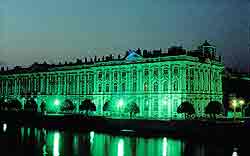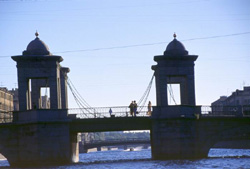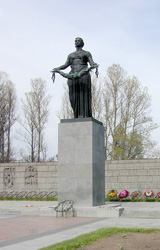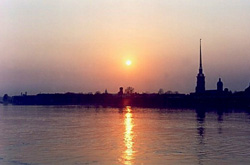Conference Venue
Saint-Petersburg in few words
It was founded in 1703 by Peter I, as a fortress, shipyard and port on the just conquered Baltic Sea shore. It took less than 10 years for a new-built city to grow up and become a capital of Russian Empire for following two centuries. The place was not very good for comfort living, actually. Saint-Petersburg was built on swamps and islands of the Neva River delta. Latitude of 60°N (nearly the same as in Alaska and Iceland) and closeness to Baltic Sea gives not so good climate. Due to a north disposal, there are famous "white nights" in June (but everybody keeps a still about "black days" in December). August is one of the fine months in Saint-Petersburg. This time is not as hot as July, but this is still not autumn. The mean day temperature is about 20oC.
In the 1st quarter of XXth century Saint-Petersburg became a scene for important
historical events. As the First World War began, it was renamed to Petrograd. After revolution
The Second World War put the city on trial. Blockade lasted for 900 days. Over 600 thousands died of gunning and starvation. About 10,000 houses were damaged or destroyed. Only "The Road of Life" over Ladozhskoe Lake connected the city to the rest of the country. Only in January 1943 blockade was gaped, and it took one more year to destroy the blockade completely. Next years the city was renovated. In 1955 Leningrad underground (Metro) was completed. It is one of the deepest in the world, and one of the most beautiful. Every station has its own architecture. Underground lines are quite long, but stations are not as numerous as in London or Paris, for example.
|
 Saint-Petersburg is often called Northern Venice, Northern Palmire, and the Northern
capital of Russia. Just 300 years old, it is one of the most beautiful cities in Europe.
Saint-Petersburg is often called Northern Venice, Northern Palmire, and the Northern
capital of Russia. Just 300 years old, it is one of the most beautiful cities in Europe.
 Peter the Great was inspired by Amsterdam channels and dreamed that his new capital will be the same.
He ordered lots of European architects to build the city. Among the first structures were Peter
and Paul's fortress and cathedral (that was used as a Romanoff's shrine also), and a House of
12 Colleges, which is now occupied by Saint-Petersburg University. But Peter's dreams didn't come
true. Anyway, though lots of channels and rivers were engulfed, much more of them still remain.
Thus there are numerous bridges in the city - over 300. Due to Neva's width, first permanent
bridge across it was built only in 1850. Most of the bridges are beautiful masterpieces of
architecture and make a deep impression.
Peter the Great was inspired by Amsterdam channels and dreamed that his new capital will be the same.
He ordered lots of European architects to build the city. Among the first structures were Peter
and Paul's fortress and cathedral (that was used as a Romanoff's shrine also), and a House of
12 Colleges, which is now occupied by Saint-Petersburg University. But Peter's dreams didn't come
true. Anyway, though lots of channels and rivers were engulfed, much more of them still remain.
Thus there are numerous bridges in the city - over 300. Due to Neva's width, first permanent
bridge across it was built only in 1850. Most of the bridges are beautiful masterpieces of
architecture and make a deep impression.
 For 200 years Saint-Petersburg was the main political and cultural center of Russia. Famous
architects (Tresini, Rossi, Rastrelli, Bazhenov, and many others) built lots of palaces for
Emperor's family and kingpins. Winter Palace, Mikhailovski Castle, Rossi Street, Kazanski
Cathedral… This is just a small part of sites that you can find at every turn around our city.
For 200 years Saint-Petersburg was the main political and cultural center of Russia. Famous
architects (Tresini, Rossi, Rastrelli, Bazhenov, and many others) built lots of palaces for
Emperor's family and kingpins. Winter Palace, Mikhailovski Castle, Rossi Street, Kazanski
Cathedral… This is just a small part of sites that you can find at every turn around our city.
 in October 1917 hard times came. In the spring of 1918 the capital was moved to Moscow. The
city name was changed once again - to Leningrad. Initial name returned only in 1991.
in October 1917 hard times came. In the spring of 1918 the capital was moved to Moscow. The
city name was changed once again - to Leningrad. Initial name returned only in 1991.
 Now Saint-Petersburg is a big modern city which plays a leading role in science, culture, policy,
and industry. In 2003 it celebrates the 300th Anniversary. Our Conference will take place at this
Jubilee year.
Now Saint-Petersburg is a big modern city which plays a leading role in science, culture, policy,
and industry. In 2003 it celebrates the 300th Anniversary. Our Conference will take place at this
Jubilee year.